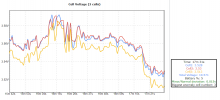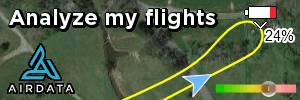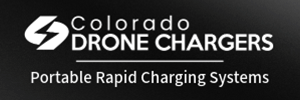I've had my Air 2s for about a month now. I try to fly it daily, it relaxes me. I noticed depending on how much I actually fly around the battery never lasts more than about 20 minutes. I'm wondering if there's any way to re-condition the batteries or fully discharge them prior to their next charge. Try to see if I can get better battery life out of them.
You are using an out of date browser. It may not display this or other websites correctly.
You should upgrade or use an alternative browser.
You should upgrade or use an alternative browser.
Any way to fully discharge / condition the batteries?
- Thread starter AFAngryWarrior
- Start date
dirkclod
Well-Known Member
With what I have always done was fly till they got low then just hover off the ground till it starts to autoland then make it stay up
i mean right off the ground till it shows 0% or just drops.
Lots disagree with that but don’t care. Works for me and been doing it since my first P2V.
i mean right off the ground till it shows 0% or just drops.
Lots disagree with that but don’t care. Works for me and been doing it since my first P2V.
S
Sounds reasonable. When I condition batteries for other devices it's typically by draining them first. Just wasn't sure if we could do that since around 4% it starts to auto-land. I'll have to force it to continue to hover next time.With what I have always done was fly till they got low then just hover off the ground till it starts to autoland then make it stay up
i mean right off the ground till it shows 0% or just drops.
Lots disagree with that but don’t care. Works for me and been doing it since my first P2V.
The procedure to discharge to 0% is coming from the past when the BMS chips in the batteries (Battery Management System) could go out of sync with the actual remaining battery capacity ... showing a wrong remaining battery percentage than the battery actually had, a 0% percent discharge synced these up. Today, the quality of the BMS chips are much better & these sync problems doesn't occur.
And the battery you have is a LiPo ... that will not suffer from any memory effect either ... so by doing this 0% discharge you gain nothing nowadays, you just throw away charge cycles.
Those that still follow this older advice will in general not do any harm to the battery ... a 0% DJI battery have approx. a cell voltage on 3,5V, so no harm at all ... but no gain either.
And the battery you have is a LiPo ... that will not suffer from any memory effect either ... so by doing this 0% discharge you gain nothing nowadays, you just throw away charge cycles.
Those that still follow this older advice will in general not do any harm to the battery ... a 0% DJI battery have approx. a cell voltage on 3,5V, so no harm at all ... but no gain either.
StantonZ
Well-Known Member
...unless you leave it at that low level for anything beyond a few hours. Your other points are well-taken in that you are just "chewing up cycles".Those that still follow this older advice will in general not do any harm to the battery ... a 0% DJI battery have approx. a cell voltage on 3,5V, so no harm at all ... but no gain either.
I don't recommend discharging any Lithium-based battery beyond 20% unless it is absolutely necessary for a particular flight plan. For the record, I "practice what I preach" where my car is concerned as well (and that chemistry is more resilient than the LiPo chemistry in our drones). My 2 cents.
dirkclod
Well-Known Member
Do as you want @AFAngryWarrior i just told you what has worked for me for over 6 years and said lots would disagree. Always do.

rexster1505
Well-Known Member
Ha, ha...unless you leave it at that low level for anything beyond a few hours...
Below is a DJI battery on 5% ... as you see, the voltage levels are a tad above 3,5V there & as soon as the battery gets unloaded & comes to rest the cells in general will recover about 0,2V when it comes to a LiPo ... so it will end up on roughly 3,7V/cell. The BMS will still report low percentages though ... the BMS recalculates when the battery gets charged.
So "a few hours" as you say is a slight overstatement ... the battery should be brought back to storage voltage within a 48h period if you want to treat it nice.

When it comes to a battery percentage on 20% I agree, that's a good level to aim for nicely landed & motors shut off ... but not necessarily due to that going lower is damaging.I don't recommend discharging any Lithium-based battery beyond 20% unless it is absolutely necessary...
Instead 15-20% is a good safety level:
- to counter for unforeseen delays during landing
- that the voltage level tends to drop faster below those percentages
- and lastly because you on those percentages still have some headroom to deal with voltage sags so no cell momentarily drops below 3.0V where the BMS in a DJI battery initiate a "forced low battery voltage auto landing".
dirkclod
Well-Known Member
- Joined
- May 25, 2017
- Messages
- 8,476
- Reactions
- 7,966
- Age
- 63
0% (coming from the BMS) doesn't mean that the voltage level is damaging low, it's really close to 3,5V/cell which isn't hurting the battery a bit.
So "a few hours" as you say is a slight overstatement ... the battery should be brought back to storage voltage within a 48h period if you want to treat it nice.
A nice considered appraisal of our more modern batteries . . . think I have enough batteries to continue landing at 20% - 25% as I have since 2017 mostly, the occasional flight to 5% or 10%, but I won't be too concerned as much now if I REALLY want that extra 10 mins to finish something 'way over there'.
dirkclod
Well-Known Member
I’m sorry but I have been discharging batterys for over 6 years
every month and never had any issues. Only good results.
Do as you want and many threads on it. I chose to do mine that
way and is my choice. Do as you want but I know what works for me.
- Joined
- May 25, 2017
- Messages
- 8,476
- Reactions
- 7,966
- Age
- 63
If you want to discharge your battery, easy way is after flying use the power bank adapter and then charge your controller, phone or other device form the battery.
Taking them down to just 10% is sufficient for conditioning the cells and will usually balance them also. Although I have all mine set up to self discharge after 5 days I condition all my batteries once a year by draining them down to 10% or less, wait for them to cool, then recharge back to 100%. All my batteries are all balanced and have no signs of any swelling.S
Sounds reasonable. When I condition batteries for other devices it's typically by draining them first. Just wasn't sure if we could do that since around 4% it starts to auto-land. I'll have to force it to continue to hover next time.
Taking them down to just 10% is sufficient for conditioning the cells and will usually balance them also. Although I have all mine set up to self discharge after 5 days I condition all my batteries once a year by draining them down to 10% or less, wait for them to cool, then recharge back to 100%. All my batteries are all balanced and have no signs of any swelling.
Good info. I have read about and now use cell voltage rather than battery percentage to tell me when I should land. I never go lower than 3.6 volts regardless of what percentage is showing. Once a year I discharge all my batteries to under 10%, wait for them to cool and recharge. This re-balances cells too. I have 12 batteries in all and all are several years old and have no signs of swelling or loss of flying time.Ha, haYeah, that's kind of a implied condition in that process ... but again, 0% (coming from the BMS) doesn't mean that the voltage level is damaging low, it's really close to 3,5V/cell which isn't hurting the battery a bit. All people that uses LiPo packs without a BMS chip knows that the first voltage alarm in the model (a FPV quad for instance) should be set at 3,5V/cell, the second alarm to 3,3V/cell ... this to give some headroom to get down before the battery sags below damaging 3.0V/cell. I'm using LiPo packs in my quads & always try to touch down at 3,5V/cell loaded ... once in a while it hits 3,4V/cell & those packs are perfectly fine even after 2 years use ... the capacity loss on the oldest packs comes with age & charge cycles, but the cell resistance is nearly equally good as a brand new pack.
Below is a DJI battery on 5% ... as you see, the voltage levels are a tad above 3,5V there & as soon as the battery gets unloaded & comes to rest the cells in general will recover about 0,2V when it comes to a LiPo ... so it will end up on roughly 3,7V/cell. The BMS will still report low percentages though ... the BMS recalculates when the battery gets charged.
So "a few hours" as you say is a slight overstatement ... the battery should be brought back to storage voltage within a 48h period if you want to treat it nice.
View attachment 150131
When it comes to a battery percentage on 20% I agree, that's a good level to aim for nicely landed & motors shut off ... but not necessarily due to that going lower is damaging.
Instead 15-20% is a good safety level:
- to counter for unforeseen delays during landing
- that the voltage level tends to drop faster below those percentages
- and lastly because you on those percentages still have some headroom to deal with voltage sags so no cell momentarily drops below 3.0V where the BMS in a DJI battery initiate a "forced low battery voltage auto landing".
Yaros
Well-Known Member
Don't discharge LiPos to 0%. The old days are over, when you needed to calibrate the BMS systems.
Just keep flying your batteries as you are, don't go below 10% regularly, and don't leave them charged for more than 72 hours, then they will be fine.
The charger automatically balances the cells while balancing.
I also label my batteries with numbers, and keep track of how many charge cycles I have on each of them, so I don't use always the same battery. For that I use a custom Android app I build that I'm planning to release maybe
Just keep flying your batteries as you are, don't go below 10% regularly, and don't leave them charged for more than 72 hours, then they will be fine.
The charger automatically balances the cells while balancing.
I also label my batteries with numbers, and keep track of how many charge cycles I have on each of them, so I don't use always the same battery. For that I use a custom Android app I build that I'm planning to release maybe
Faster
Well-Known Member
Do you know what's the cell Voltage of a DJI battery at 0%? I'm asking because it all depends on where DJI decided to put its scale from 0-100%.Don't discharge LiPos to 0%. The old days are over, when you needed to calibrate the BMS systems.
Just keep flying your batteries as you are, don't go below 10% regularly, and don't leave them charged for more than 72 hours, then they will be fine.
The charger automatically balances the cells while balancing.
I also label my batteries with numbers, and keep track of how many charge cycles I have on each of them, so I don't use always the same battery. For that I use a custom Android app I build that I'm planning to release maybe
Last edited:
See post #8Do you know what's the cell Voltage of a DJI battery at 0%?...
Faster
Well-Known Member
That's the reason why I was asking him. I read your post since you wrote it. 0% for DJI would NEVER be the real Lipo 0% (3.0V/cell)See post #8
Aha ...That's the reason why I was asking him. I read your post since you wrote it. 0% for DJI would NEVER be the real Lipo 0% (3.0V/cell)
The chosen voltage level of 3,5V/cell to indicate 0% is a logical safety level if looking at a LiPo discharge profile ... as seen below the discharge profile suggests that 3,5V is a proper level ... after that the voltage drops rapidly, only the discharge rate shifts the drop somewhat. So if flying to 0% will most probably mean that you risk to end up on damaging low voltage levels if you encounter even the slightest delay.
3,5V/cell is as such not critical damaging, but bear in mind that the wear on the battery isn't black & white, the closer you go to either full or empty & the more often you do it ... means more wear on the battery & in the end a shorter service life.

Similar threads
- Replies
- 22
- Views
- 2K
- Replies
- 0
- Views
- 1K
DJI Drone Deals
New Threads
-
-
Avatar: Fire and Ash Drone Light Show.
- Started by The Droning Company
- Replies: 0
-
Globalstar and Skydio Trial Validates D2D for Drones.
- Started by The Droning Company
- Replies: 0
-
-
Northrop Grumman AION Tackles Drone Threats.
- Started by The Droning Company
- Replies: 0
Members online
Total: 3,384 (members: 7, guests: 3,377)











